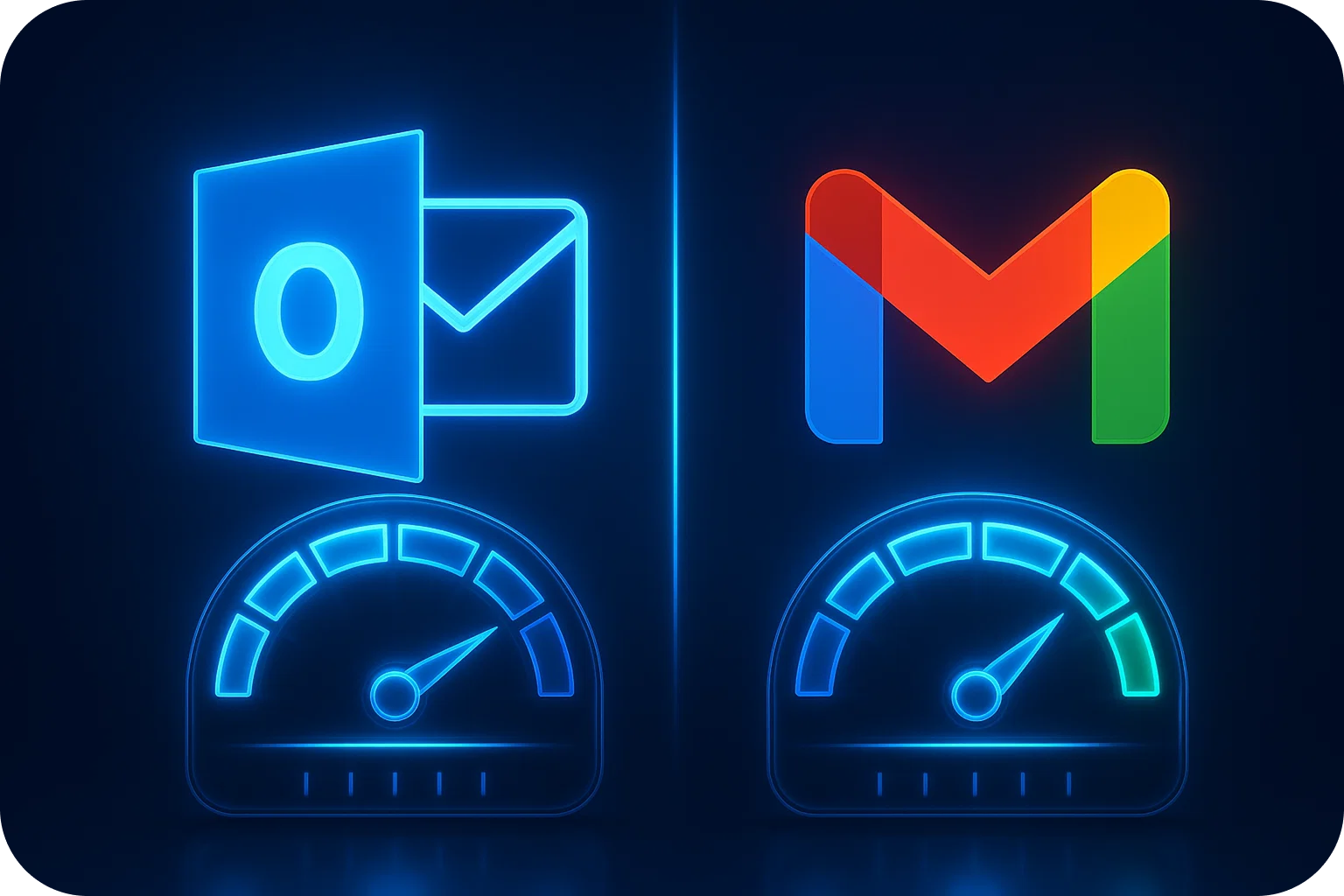Google Workspace vs Microsoft 365 vs Shared IP
.png)
When it comes to cold email outreach, your email infrastructure choice can make or break your campaigns. With deliverability rates directly impacting your revenue, choosing between Google Workspace, Microsoft 365, and shared IP setups isn't just a technical decision; it's a strategic business choice that affects your bottom line.
In this comprehensive guide, we'll break down the key differences between these three email infrastructure options, helping you make an informed decision that maximizes your cold email success while optimizing costs and scalability.
Understanding Your Email Infrastructure Options
Before diving into the comparison, it's crucial to understand what each option offers and why your choice matters for cold email campaigns.
Google Workspace
Google Workspace provides professional email hosting through Gmail's infrastructure, offering the reliability and reputation of Google's email servers. With over 2 billion active Gmail users, your emails benefit from Google's established sender reputation and advanced spam filtering algorithms.
Microsoft 365 (Outlook)
Microsoft 365 delivers enterprise-grade email through Outlook, leveraging Microsoft's robust infrastructure and integration with the broader Microsoft ecosystem. It's particularly popular among enterprise clients who rely on Microsoft's suite of productivity tools.
Shared IP Email Solutions
Shared IP setups allow multiple users to send emails from a rotative IP address, distributing costs while maintaining reasonable deliverability. This option is often more budget-friendly for businesses just starting their cold email journey.
Deliverability: The Make-or-Break Factor
Deliverability is the cornerstone of successful cold email campaigns. Here's how each option performs:
Google Workspace Deliverability
Inbox Placement Rate: 96-98%
Google Workspace consistently delivers exceptional inbox placement rates across major email providers. Gmail's sophisticated machine learning algorithms and established sender reputation provide several advantages:
- Strong domain authority from Google's infrastructure
- Advanced spam detection that works in your favor
- Excellent reputation with other email providers
- Robust authentication protocols (SPF, DKIM, DMARC)
Microsoft 365 Deliverability
Inbox Placement Rate: 94-97%
Microsoft 365 offers solid deliverability performance, particularly strong with Outlook and other Microsoft-based email systems:
- Enterprise-grade infrastructure with high reliability
- Strong performance with B2B audiences using Outlook
- Comprehensive security features that boost sender reputation
- Integration with Microsoft's threat intelligence network
Shared IP Deliverability
Inbox Placement Rate: 96-98%
Shared IP solutions can achieve impressive deliverability when properly managed:
- A cost-effective way to maintain a good sender reputation
- Shared reputation can benefit from other users' good practices
- Requires careful monitoring to avoid reputation damage
- Performance varies based on IP pool management
Security and Compliance Comparison
Security isn't just about protecting your data; it's about maintaining the trust that drives deliverability.
Google Workspace Security
- Enterprise-grade encryption in transit and at rest
- Advanced threat protection and phishing detection
- GDPR, CCPA, and SOC2 compliance
- Two-factor authentication and advanced admin controls
- Regular security updates and patches
Microsoft 365 Security
- Microsoft Defender integration for advanced threat protection
- Comprehensive compliance tools for various regulations
- Advanced data loss prevention (DLP) capabilities
- Zero Trust security architecture
- Extensive audit and reporting features
Shared IP Security
- Basic encryption and security protocols
- Compliance depends on the specific provider
- Limited advanced security features
- Shared responsibility model for security
- Cost-effective basic protection
Scalability: Growing Your Cold Email Operations
As your business grows, your email infrastructure needs to scale efficiently without compromising performance.
Google Workspace Scalability
Google Workspace excels at scaling cold email operations:
- Recommended limit: 20 emails per inbox per day
- Maximum capacity: 100 emails per inbox per day
- Easy integration with popular cold email tools
- Seamless addition of new domains and inboxes
- Consistent performance across different volumes
Microsoft 365 Scalability
Microsoft 365 offers robust scalability for enterprise needs:
- Similar sending limits to Google Workspace
- Strong integration with the Microsoft ecosystem
- Enterprise-focused scaling options
- Advanced admin controls for large teams
- Flexible licensing for different user types
Shared IP Scalability
Shared IP solutions provide cost-effective scaling:
- Lower per-inbox costs enable larger operations
- Flexible volume-based pricing models
- Quick setup for rapid scaling
- Suitable for high-volume, cost-conscious operations
- Performance monitoring becomes more critical at scale
Cost Analysis: Finding the Right Balance
Understanding the true cost of each option helps you optimize your cold email ROI.
Pricing Breakdown
Shared IP - $3/month - Cost-conscious scaling
Google Workspace- $4/month - Balanced performance and cost
Microsoft 365 - $5/month - Enterprise integration needs
Total Cost of Ownership Considerations
- Setup and maintenance time
- Integration costs with existing tools
- Potential deliverability impact on revenue
- Support and troubleshooting resources
- Compliance and security overhead
Integration and Compatibility
Your email infrastructure must work seamlessly with your existing cold email tools and workflows.
Popular Tool Integrations
All three options integrate well with leading cold email platforms:
- Instantly
- Lemlist
- Smartlead
- Reply
- SalesHandy
They also work effectively with AI SDR agents like Luna and 11x, making them suitable for automated outreach campaigns.
Best Practices for Each Option
Google Workspace Best Practices
- Implement proper domain authentication (SPF, DKIM, DMARC)
- Use 3-5 inboxes per domain maximum
- Maintain consistent sending patterns
- Monitor reputation through Google Postmaster Tools
- Warm up new inboxes for 3-4 weeks before full-scale sending
Microsoft 365 Best Practices
- Leverage Microsoft's security features for better reputation
- Use Exchange Online Protection settings appropriately
- Monitor through Microsoft 365 security center
- Implement conditional access policies
- Regular security audits and compliance checks
Shared IP Best Practices
- Choose providers with strong IP pool management
- Monitor deliverability metrics closely
- Maintain good sending practices to protect shared reputation
- Have backup options ready for IP reputation issues
- Regular performance reviews and provider evaluation
Making the Right Choice for Your Business
Choose Google Workspace If:
- You prioritize maximum deliverability rates
- You want the best balance of cost and performance
- Your team is already familiar with Google's ecosystem
- You need reliable, consistent performance
- You're targeting B2C or mixed audiences
Choose Microsoft 365 If:
- Your organization already uses Microsoft tools
- You're primarily targeting B2B audiences using Outlook
- You need advanced compliance and security features
- Enterprise integration is a priority
- You require extensive admin controls
Choose Shared IP If:
- Cost optimization is your primary concern
- You're testing cold email strategies
- You need to scale quickly
- You have experience managing email reputation
- Volume is more important than premium features
Implementation Timeline and Warm-up Strategy
Regardless of your choice, proper implementation is crucial for success:
Week 1-2: Setup and Configuration
- Domain and inbox creation
- DNS configuration and authentication
- Integration with cold email tools
- Initial testing and verification
Week 3-6: Warm-up Phase
- Gradual increase in sending volume
- Engagement monitoring and optimization
- Deliverability tracking and adjustments
- Performance baseline establishment
Week 7+: Full-scale Operations
- Maximum recommended sending volumes
- Ongoing monitoring and optimization
- Regular performance reviews
- Scaling and expansion planning
Maximizing Your Cold Email Success
The choice between Google Workspace, Microsoft 365, and shared IP solutions ultimately depends on your specific needs, budget, and growth plans. Google Workspace offers the best balance of deliverability and cost for most businesses, while Microsoft 365 excels in enterprise environments with existing Microsoft infrastructure. Shared IP solutions provide cost-effective scaling for volume-focused operations.
Remember that successful cold email campaigns depend on more than just your email infrastructure. Proper setup, consistent monitoring, and adherence to best practices are essential regardless of your chosen platform.
The key is to start with a solution that matches your current needs while providing room for growth. With proper implementation and management, any of these options can deliver the 96-98% inbox placement rates necessary for successful cold email campaigns.
Ready to optimize your cold email infrastructure? Consider your specific requirements, evaluate the total cost of ownership, and choose the solution that best aligns with your business goals and growth trajectory.
More articles
Get started now




%201.png)





